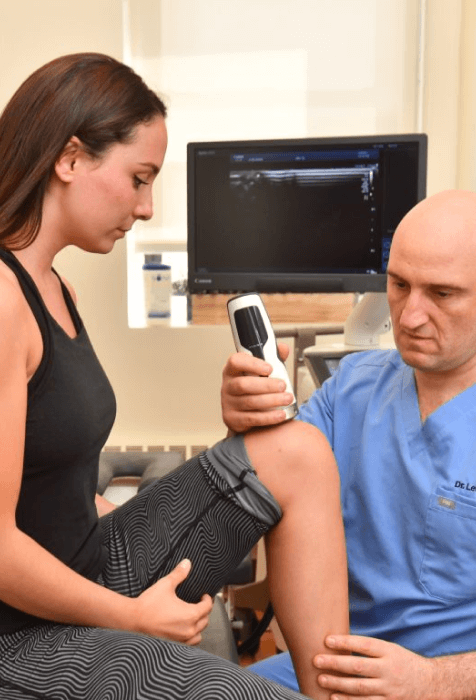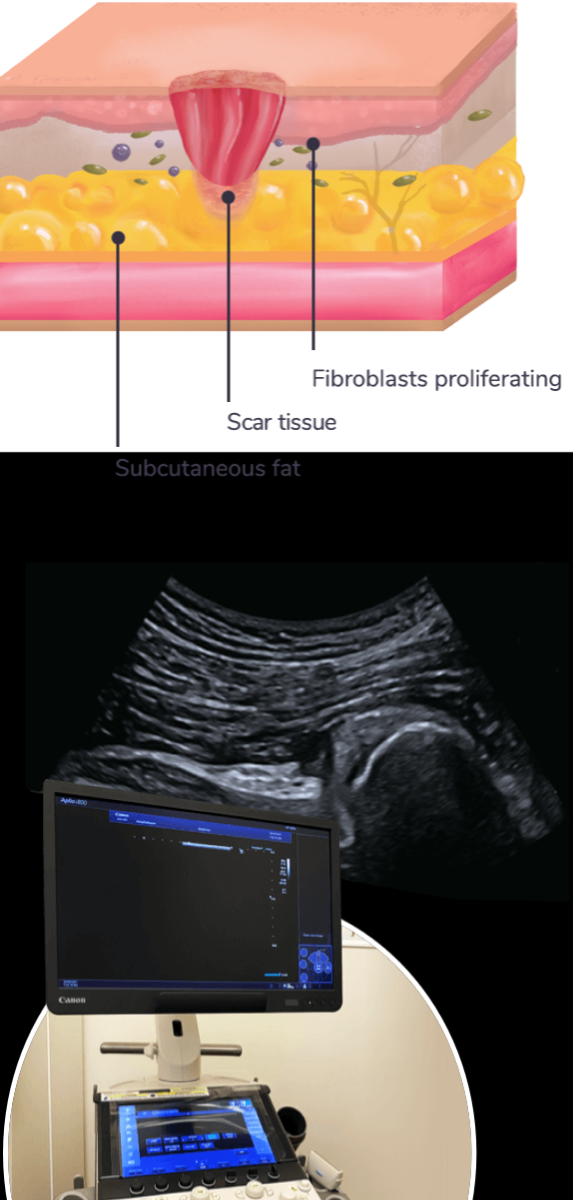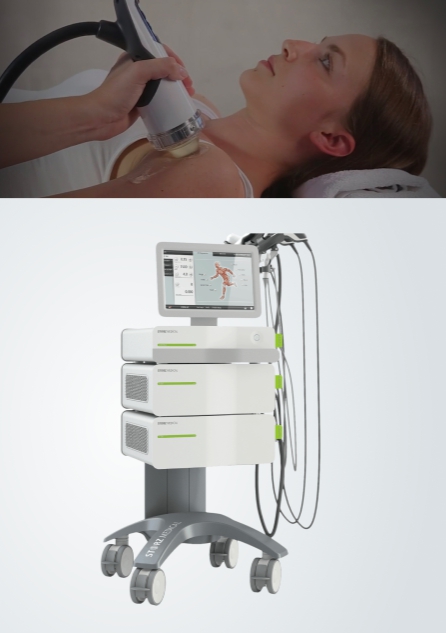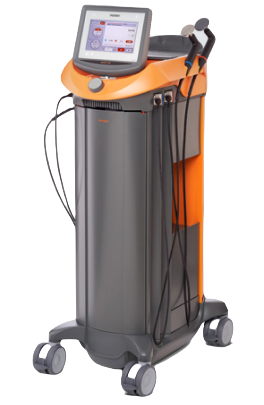Scar tissue is a special type of fibrous tissue that your body generates to repair damaged soft tissues. Unlike muscle tissue, which is made of contractile fibers, scar tissue is made of collagen, which has limited vascularity and lacks the elastic and contractile properties of muscle fibers.
During the healing process, scar tissue can adhere to other structures, inhibiting movement, causing pain, and preventing soft tissues from gliding smoothly among other structures. Extracorporeal shockwave therapy (ESWT) can help to eliminate scar tissue adhesions and restore pain-free functional movement.
or
Dr. Kalika is an expert in extracorporeal shockwave therapy, and has published multiple scientific studies on the topic. He is highly skilled and experienced in diagnostic ultrasonography, and is considered one of the world’s top experts in ultrasound guided procedures. Dr. Kalika uses ultrasound imaging to detect scar tissue anomalies, and to guide therapeutic shockwave treatment.
Dr. Kalika has devoted his career to finding the most advanced technologies and innovative treatment approaches for resolving pain syndromes, rehabilitating injuries, and restoring pain-free functional movement. He is certified in the Stecco Method of fascial manipulation therapy, a manual approach that helps to release tissue adhesions and remodel scar tissue.
The clinic at NYDNRehab features some of the most advanced technologies available, rarely found in private clinics. Patient care at NYDNRehab is holistic and personalized, to ensure fast and effective results.

Physical therapy can help to restore functional movement after an injury or surgery, but it is not a standalone solution. Prior to beginning physical therapy, scar tissue and fascia adhesions need to be addressed, to free up soft tissues and restore unrestricted movement.
Focused extracorporeal shockwave therapy (ESWT) is an evidence-based approach for treating scar tissue. Yet many clinics only offer radial shockwave therapy, which is not a true shockwave and does not render the same results as ESWT.
Dr. Kalika’s expertise in extracorporeal shockwave therapy, along with over 20 years of experience treating and rehabilitating soft tissue injuries and movement disorders, make NYDNRehab the clinic of choice for scar tissue therapy in NYC.
The chosen treatment protocol for scar tissue is largely dependent on the location and maturity level of the tissue. For recent wounds in the early phases of healing, scar tissue is still pliable and can be remodeled. Mature scar tissue is more difficult to remodel and may require a more advanced and multimodal intervention strategy.
Scar tissue is formed in four progressive phases:
Phase 1: Inflammatory phase
This phase occurs immediately after trauma and lasts between 24-48 hours. It begins with blood clotting and the migration of macrophages and histiocytes to remove dead tissue from the damaged area. The injured area is normally immobilized during this phase to prevent further damage.
Phase 2: Granulation phase
In this phase, a temporary increase in vascularity occurs, to nourish the healing tissue. The rate of scar tissue formation correlates with tissue vascularity, with tendons and ligaments requiring more time than muscle. Some limited movement is helpful in this phase, to ensure that scar tissue is laid down in patterns that do not inhibit movement as it matures.
Phase 3: Fibroblastic phase
During phase 3, the number of fibroblasts and the rate of collagen production increases. Collagen binds to itself with weak hydrostatic bonds that make it pliable, allowing for the reshaping and molding of scar tissue with minimal risk of reinjury. This stage lasts 3 to 8 weeks.
Phase 4: Maturation phase
Collagen solidifies and shrinks during this final phase, and the tissue is able to tolerate stress without risk of reinjury. Significant tissue remodeling can still take place with appropriate mobilization. Failure to mobilize scar tissue in this phase can cause cross-linking of collagen fibers and tissue shrinkage. Toward the end of this phase, mature tissue loses its pliability and becomes more difficult to remodel.
At NYDNRehab, we use high resolution diagnostic ultrasound to visualize scar tissue in real time, to detect areas of abnormal collagen modeling and adhesions, and to identify areas where scar tissue restricts functional movement.


ESWT has been shown to significantly improve multiple scar tissue parameters, such as height, pliability, vascularity, and pigmentation. Its mechanism of action is to reduce the fibrous component of scar tissue by regenerating and remodeling affected tissues.
ESWT has been shown to significantly improve multiple scar tissue parameters, such as height, pliability, vascularity, and pigmentation. Its mechanism of action is to reduce the fibrous component of scar tissue by regenerating and remodeling affected tissues.
In addition to shockwave therapy, your treatment protocol may include physical therapy and other therapeutic approaches, to reduce pain and restore pain-free movement.

TECAR therapy dramatically speeds up tissue healing by normalizing electrical charges within damaged cells. When combined with Stecco manipulation therapy, TECAR works to accelerate tissue healing and restore its integrity.
Hydrodissection is a technique for treating peripheral nerves entrapped by scar tissue. It involves injecting a saline solution under ultrasound guidance, to separate entrapped nerves from surrounding scar tissue and adjacent structures.

If left untreated, scar tissue can cause pain and severely restrict your ability to move freely. Scar tissue should be addressed as early as possible after an injury or surgery, to minimize restrictions and adhesions, and to optimize tissue remodeling.
At NYDNRehab, we use the most advanced technologies and therapeutic approaches to limit scar tissue damage and release adhesions that impair movement. If you were never treated for scar tissue after a recent injury or surgery, or if an old injury has restricted your mobility, contact NYDNRehab today, and get moving again with scar tissue therapy.
Dr. Lev Kalika is a world-recognized expert in musculoskeletal medicine. with 20+ years of clinical experience in diagnostic musculoskeletal ultrasonography, rehabilitative sports medicine and conservative orthopedics. In addition to operating his clinical practice in Manhattan, he regularly publishes peer-reviewed research on ultrasound-guided therapies and procedures. He serves as a peer reviewer for Springer Nature.
Dr. Kalika is an esteemed member of multiple professional organizations, including: